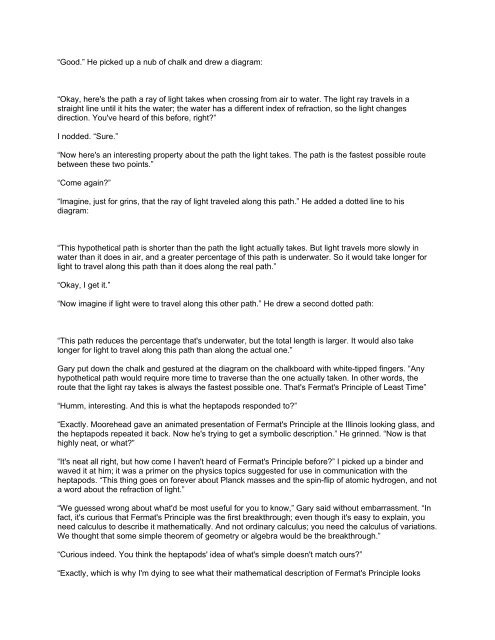Create successful ePaper yourself
Turn your PDF publications into a flip-book with our unique Google optimized e-Paper software.
“Good.” He picked up a nub <strong>of</strong> chalk and drew a diagram:<br />
“Okay, here's the path a ray <strong>of</strong> light takes when crossing from air to water. The light ray travels in a<br />
straight line until it hits the water; the water has a different index <strong>of</strong> refraction, so the light changes<br />
direction. You've heard <strong>of</strong> this before, right?”<br />
I nodded. “Sure.”<br />
“Now here's an interesting property about the path the light takes. The path is the fastest possible route<br />
between these two points.”<br />
“Come again?”<br />
“Imagine, just for grins, that the ray <strong>of</strong> light traveled along this path.” He added a dotted line to his<br />
diagram:<br />
“This hypothetical path is shorter than the path the light actually takes. But light travels more slowly in<br />
water than it does in air, and a greater percentage <strong>of</strong> this path is underwater. So it would take longer for<br />
light to travel along this path than it does along the real path.”<br />
“Okay, I get it.”<br />
“Now imagine if light were to travel along this other path.” He drew a second dotted path:<br />
“This path reduces the percentage that's underwater, but the total length is larger. It would also take<br />
longer for light to travel along this path than along the actual one.”<br />
Gary put down the chalk and gestured at the diagram on the chalkboard with white-tipped fingers. “Any<br />
hypothetical path would require more time to traverse than the one actually taken. In other words, the<br />
route that the light ray takes is always the fastest possible one. That's Fermat's Principle <strong>of</strong> Least Time”<br />
“Humm, interesting. And this is what the heptapods responded to?”<br />
“Exactly. Moorehead gave an animated presentation <strong>of</strong> Fermat's Principle at the Illinois looking glass, and<br />
the heptapods repeated it back. Now he's trying to get a symbolic description.” He grinned. “Now is that<br />
highly neat, or what?”<br />
“It's neat all right, but how come I haven't heard <strong>of</strong> Fermat's Principle before?” I picked up a binder and<br />
waved it at him; it was a primer on the physics topics suggested for use in communication with the<br />
heptapods. “This thing goes on forever about Planck masses and the spin-flip <strong>of</strong> atomic hydrogen, and not<br />
a word about the refraction <strong>of</strong> light.”<br />
“We guessed wrong about what'd be most useful for you to know,” Gary said without embarrassment. “In<br />
fact, it's curious that Fermat's Principle was the first breakthrough; even though it's easy to explain, you<br />
need calculus to describe it mathematically. And not ordinary calculus; you need the calculus <strong>of</strong> variations.<br />
We thought that some simple theorem <strong>of</strong> geometry or algebra would be the breakthrough.”<br />
“Curious indeed. You think the heptapods' idea <strong>of</strong> what's simple doesn't match ours?”<br />
“Exactly, which is why I'm dying to see what their mathematical description <strong>of</strong> Fermat's Principle looks



